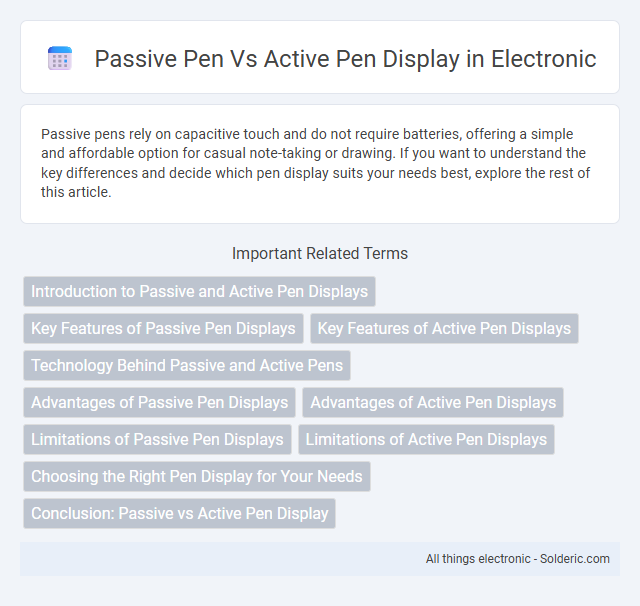Passive pens rely on capacitive touch and do not require batteries, offering a simple and affordable option for casual note-taking or drawing. If you want to understand the key differences and decide which pen display suits your needs best, explore the rest of this article.
Comparison Table
| Feature | Passive Pen | Active Pen Display |
|---|---|---|
| Technology | Capacitive touch or simple stylus | Digitizer with pressure sensitivity and electronics |
| Pressure Sensitivity | No or minimal | High (up to 8192 levels) |
| Accuracy | Low | High |
| Battery Required | No | Yes |
| Palm Rejection | No | Yes |
| Features | Basic pointing and tapping | Pressure, tilt, programmable buttons, eraser |
| Compatibility | Works with standard touchscreens | Requires compatible active digitizer display |
| Use Cases | Simple navigation and annotations | Professional drawing, design, precise input |
| Cost | Low | Higher |
Introduction to Passive and Active Pen Displays
Passive pen displays use capacitive touch technology, relying on the screen to detect stylus input without electronics in the pen itself, offering a simpler and more affordable solution for casual drawing and note-taking. Active pen displays integrate a digitizer layer and contain electronic components within the stylus, providing enhanced precision, pressure sensitivity, and palm rejection capabilities essential for professional digital art and design work. Differences in functionality and technology make active pens ideal for graphic designers, while passive pens suit basic touchscreen interactions and general tablet use.
Key Features of Passive Pen Displays
Passive pen displays feature a simple design without batteries or electronic components, relying on electromagnetic resonance technology to detect pen input. These displays typically offer light-weight pens with no need for charging but may lack pressure sensitivity and advanced tilt recognition found in active pen displays. You'll find passive pen displays ideal for basic sketches or note-taking where cost-effectiveness and portability are prioritized over complex input capabilities.
Key Features of Active Pen Displays
Active pen displays feature pressure sensitivity, tilt recognition, and customizable buttons, offering precise control and a natural drawing experience. These displays often support palm rejection technology, allowing you to rest your hand on the screen without interfering with input. Enhanced responsiveness and higher accuracy distinguish active pen displays from passive pen models, making them ideal for professional digital artists and designers.
Technology Behind Passive and Active Pens
Passive pens utilize capacitive touch technology, relying on the electrical conductivity of the user's hand to interact with the display, which means they lack built-in electronics or batteries. Active pens incorporate advanced digitizer technology with sensors and processors, enabling features like pressure sensitivity, palm rejection, and tilt recognition by communicating directly with the device through Bluetooth or proprietary protocols. The active pen's internal electronics process input signals independently, providing more precise and responsive performance compared to the simpler, technology-free passive pen.
Advantages of Passive Pen Displays
Passive pen displays offer greater compatibility with various devices due to their simple electromagnetic resonance technology, making them lightweight and battery-free for uninterrupted use. Their durable design often results in longer lifespan and less maintenance compared to active pens, which require batteries and have more complex components. You benefit from affordability and ease of use, especially for casual drawing or note-taking without the need for advanced pressure sensitivity or tilt recognition.
Advantages of Active Pen Displays
Active pen displays offer superior precision and responsiveness due to built-in digitizers that detect pressure sensitivity and tilt, enhancing drawing and writing accuracy. These displays provide features like customizable buttons and palm rejection, improving user experience for artists and designers. The ability to seamlessly interact with software through multi-level pressure levels makes active pen displays ideal for detailed digital artwork and professional graphic design.
Limitations of Passive Pen Displays
Passive pen displays often suffer from limited pressure sensitivity, resulting in less precise and less natural drawing experiences compared to active pen displays. They typically lack advanced features such as tilt recognition and palm rejection, which can hinder detailed artistic work and productivity. Your creative potential may be restricted by lag or inconsistent line quality, making passive pen displays less suitable for professional use.
Limitations of Active Pen Displays
Active pen displays often face limitations such as battery dependency, which can interrupt usage when power is depleted. They may experience latency issues, affecting the precision of drawing or writing, especially in fast, detailed work. Compatibility constraints with certain devices and higher cost compared to passive pen systems also restrict widespread adoption.
Choosing the Right Pen Display for Your Needs
Choosing between a passive pen and an active pen display depends on your drawing style and precision needs. Passive pen displays offer simplicity and require no batteries, making them ideal for casual note-taking and basic sketches. Your decision should consider active pens' pressure sensitivity and tilt recognition, which provide enhanced accuracy and control for detailed digital art and professional design work.
Conclusion: Passive vs Active Pen Display
Passive pen displays offer a budget-friendly option with basic stylus input but lack pressure sensitivity and advanced features, limiting precision and creative control. Active pen displays provide enhanced responsiveness, pressure sensitivity, and tilt recognition, making them ideal for digital artists and professionals requiring detailed work. Your choice depends on whether affordability or advanced functionality is the priority for your drawing or design needs.
Passive pen vs Active pen display Infographic

 solderic.com
solderic.com